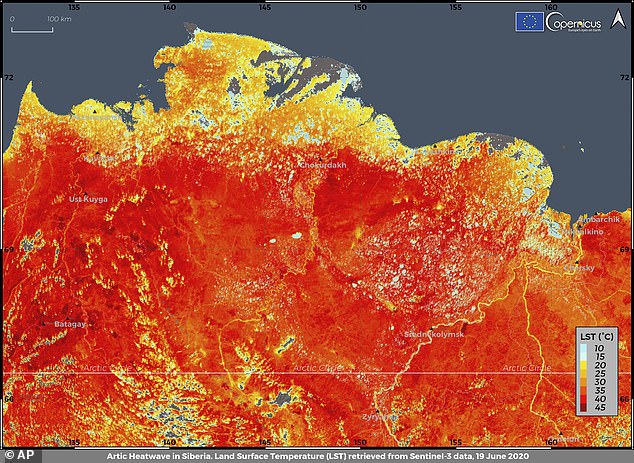Siberia’s June heatwave saw temperatures soar 10°C above average with a new record high of 38°C
- Siberia recorded its hottest June on record, according to satellite data
- Temperatures peaked at around 10°C higher than the historical average
- On average, the entire month was more than 5°C above normal levels
Arctic Siberia saw exceptionally high temperatures last month as it sweltered in a heatwave which made it the region’s hottest June on record.
When compared to the average temperature of Siberia in June from 1950 – 2019, this year reached up to 10°C higher.
The average overall, for he entire Russian region, was in excess of 5°C.
Siberia is a frigid region, normally averaging just 16°C on a June day, but on June 20, it recorded an all-time high temperature of 38°C.
Scroll down for video
A satellite image showing a record-breaking temperature of 38 degrees Celsius (100.4 degrees Fahrenheit) registered in the Arctic town of Verkhoyansk on Saturday, June 20
A month of intense fires in the Arctic Circle has also been recorded, even exceeding the record levels of blazes seen in the region in June 2019.
Globally, last month was on a par with 2019 for the hottest June on record.
Temperatures were 0.53°C above the 1981 to 2010 average around the world and Europe saw its joint second warmest June on record.
Temperatures in Arctic Siberia were exceptionally warm, C3S experts said.

Average temperatures in Arctic Siberia were as high as 10C above normal for June, according to the Copernicus Climate Change Service

On average, the entire month of June was more than 5°C above normal levels, exceeding the previous records set in 2018 and 2019

Pictured, children play in the Krugloe lake outside Verkhoyansk, the Sakha Republic, about 4,660 kilometers (2,900 miles) northeast of Moscow, Russia
In eastern Siberia, C3S, which uses satellite observations, estimated a maximum hourly Arctic temperature of 37°C on June 20.
On the same day, a weather station reported a record temperature of 38°C on the same day – although that has not yet been confirmed.
Director of the C3S at ECMWF, Carlo Buontempo, said: ‘Finding what caused these record temperatures is not a straightforward endeavour as there are many contributing factors interacting with each other.
‘Siberia and the Arctic Circle in general have large fluctuations from year to year and have experienced other relatively warm Junes before.
‘What is worrisome is that the Arctic is warming faster than the rest of the world.
‘Western Siberia experiencing warmer-than-average temperatures so long during the winter and spring is unusual, and the exceptionally high temperatures in Arctic Siberia that have occurred now in June 2020 are equally a cause for concern.’
The higher temperatures and dry soils have contributed to increased fire activity, mostly in the far north-east of Siberia.
The burning fires had resulted in the highest estimated emissions in 18 years of monitoring, with an estimated 59 million tonnes of carbon dioxide released into the atmosphere in June, more than last June’s total of 53 million tonnes.
Experts at the Met Office said the high temperatures in northern Eurasia were due to a combination of climate change and extreme climate variability.
